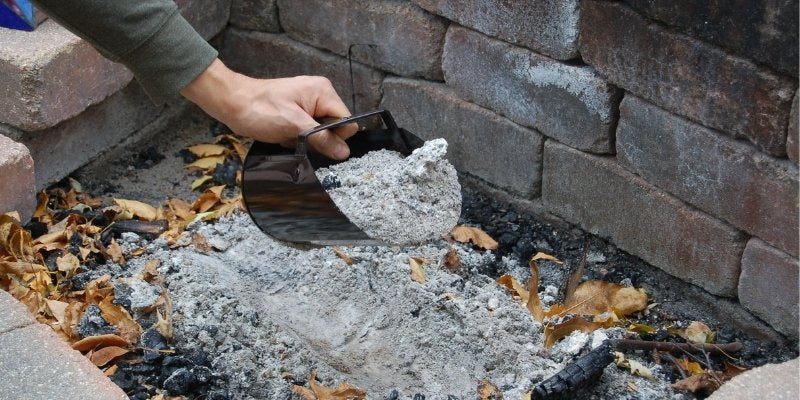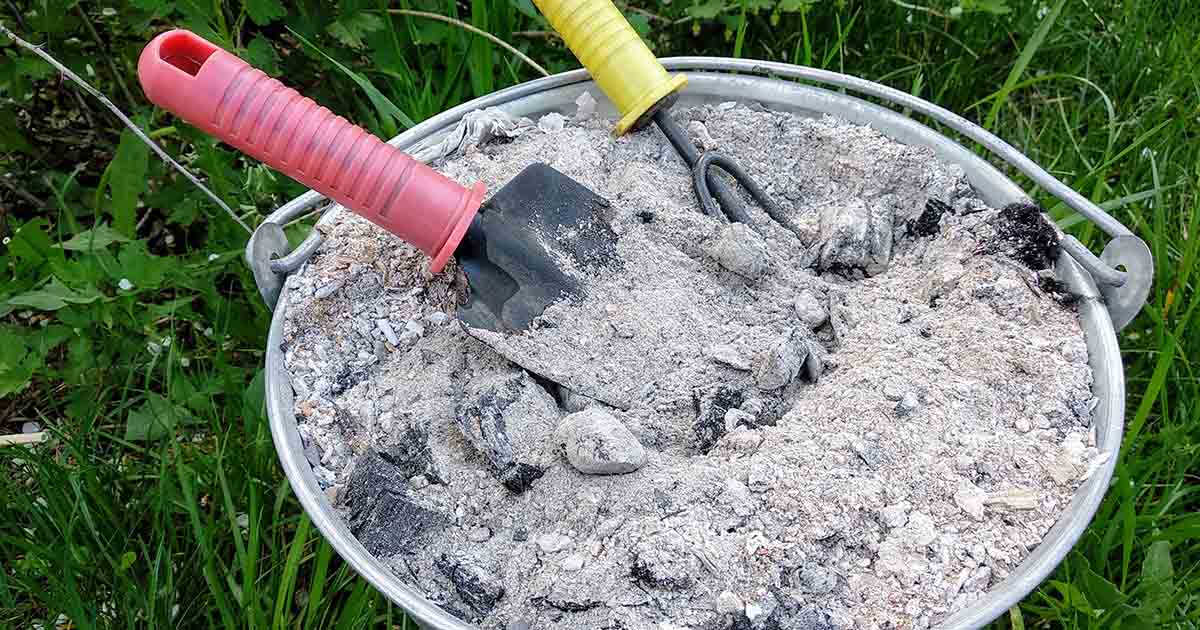Call us at 725-239-9966!
M-F: 8 AM-7 PM PST
Call us at 725-239-9966!
M-F: 8 AM-7 PM PST

A crackling fire in the backyard fire pit is one of life's simple pleasures. But once the flames die down, you're left with a pile of ashes. Instead of just dumping them in the trash, there are numerous ways to reuse these ashes around your home and garden.
Fire pit ashes are alkaline and contain beneficial nutrients like potassium, calcium, and magnesium. When handled properly, ashes can be used as a natural fertilizer, pest deterrent, cleaning agent, and more. This guide will walk you through how to safely collect fire pit ashes and give you 10 creative ideas for reusing them.
Before doing anything else with your leftover fire pit ashes, it's crucial to handle them properly for safety. Here are some key tips:
Allow ashes to cool completely before handling - Ashes from wood or charcoal can remain dangerously hot long after the fire has been extinguished. It's recommended to wait at least 24 hours after your last flames to ensure that the ashes have cooled entirely.
Use metal containers to collect and store ashes - Carefully transfer the completely cooled ashes to a metal bucket or other non-flammable container. Avoid plastic. If the ashes are still warm, they can be dampened with water to expedite the cooling process.
Keep ashes in a safe outdoor location - The ash container should be kept at least 10 feet away from your home and any combustible materials like dried leaves or twigs until all the refuse is reused or hauled away.
Storing cooled ashes properly is important to prevent fires or burns. Always err on the side of caution when handling fire remnants.

From fertilizing the garden to making soap, there are many uses for wood ash around the house and yard.
Wood ash contains calcium, potassium, and trace minerals. This makes it useful as a soil amendment for garden beds and lawns. Sprinkle a thin layer of cooled ash over the soil or till it in gently.
The ash will help raise the pH of acidic soils. It also provides potassium, an essential nutrient for flower and vegetable plants. Using wood ash fertilizes organically without chemicals.
A sprinkle of ash in your compost bin can accelerate decomposition. The calcium in the ash offsets the nitrogen and acids produced during composting. This helps regulate pH levels.
The potassium and carbon also feed the microbes, fungi, and worms working to break down the organic matter. Just a light dusting of ash is enough to enrich the compost for your garden.
With some basic chemistry skills, the ash from hardwoods can be used to produce lye for soap making. This traditional process involves boiling the ashes in soft water and then collecting the alkaline lye solution from the top.
Once cooled, the lye is combined with oils like olive and coconut to saponify into handmade soap. It takes practice, but you can make lye yourself using ashes instead of buying chemicals.
Gardeners have utilized wood ash as a natural pest deterrent for generations. The alkaline ash disrupts soft-bodied insects and slugs slithering around in the vegetable patch.
Lightly sprinkling ash around plants creates an irritating barrier that certain pests avoid. It can also distort their natural scent trails. But go easy, as too much ash will increase soil pH excessively.
In addition to direct application, wood ash can be blended into anti-pest sprays:
Mix 1-2 tablespoons of ash into water to create a basic insecticidal solution.
For added pest-fighting power, steep chopped garlic, mint, and tobacco in ash water overnight before spraying onto affected plants.
Adding a small amount of mild soap helps the mixture stick to the leaves better. Always test on a few leaves first to avoid plant damage.
These natural ash solutions deter common garden pests like aphids, mites, and caterpillars when applied regularly.
The gritty texture and alkaline pH of ash make it useful for scrubbing surfaces. Apply a paste of ash and water to clean the stubborn grime off:
Gently rub the ash paste onto the surface with a damp cloth. Rinse thoroughly afterward. The ash will remove grease and burnt-on food easily.
Have a leaky car or motorcycle creating oily stains on your driveway? Cover the slick spots with a layer of cooled wood ash to soak it up safely.
Ash absorbs and dries out petroleum spills. Once the ash has turned dark with absorbed oil, sweep it up and throw it away. An ash spill mat can also prevent future drips from damaging concrete.
Ash contains potassium salts that help melt ice in very cold conditions. Spreading some on frosty steps and pathways can provide grip.
It won't melt thick ice fully. But a light coating does offer improved traction versus slick concrete. Clean up any excess once temperatures warm.
A bucket of dry ash near the fire pit is handy for extinguishing the flames in an emergency or when finished using the fire. Throwing a handful of ash onto the logs will dampen down the fire quickly.
Having an ash bucket ready nearby before starting a fire is always wise. Ash cuts off the flames' oxygen supply.
For chickens in a coop, an ash dust bathing area allows them to clean their feathers and suffocate external parasites. Chickens use fine loose soil or sand to bathe in. But ashes are highly preferred.
Place a small tray of ash in their coop for chickens to roll and bathe in. Be sure they have ample access to clean water afterward. The ash smothers mites while fluffing their plumage.
Now that you've put those ashes to use around the homestead, it's time to dispose of what remains properly.

If you still have ashes remaining after reusing them, proper disposal is important. Here are some ashes disposal tips:
Reuse ashes whenever possible first - As outlined above, ashes can be reused in many clever ways around your home and garden. Always try to find an application for them before disposal.
Allow ashes to fully cool before disposal - Ashes must be completely cooled before you dispose of them. Otherwise, they pose a fire hazard. Let them sit in the metal container for at least 48 hours before disposal.
Use as landfill waste or check local regulations - Your cooled ashes can be disposed of in your normal landfill waste. However, always check your local municipal regulations first, as some towns may have specific ash disposal policies to follow.
When in doubt, contact your local waste management company to ask about fire pit ash disposal protocols in your area. Safety first when getting rid of ashes.
Instead of treating ashes from your outdoor wood fire pit or fireplace as waste, view them as a useful resource. With creativity and our tips, you can reuse the leftover ashes in eco-friendly ways to benefit your homestead. Always handle ashes safely by letting them fully cool before reuse or disposal.
Follow this complete guide to get the most out of the ashes while keeping your family safe. A few simple applications like using wood ash with water to form a natural cleaner or sprinkling a small amount around plants to deter slugs and snails will divert waste, nourish your soil, clean your home, and benefit the environment.
Plus you'll lower your waste footprint. So don't throw those ashes output them to clever uses instead after making sure the ashes are completely cool!

Wood ash can be a useful garden fertilizer, as it contains minerals that plants need. You can add to your lawn and garden by sprinkling a thin layer of ash on top of the soil. Keep in mind that wood ash is alkaline, so avoid acid-loving plants like blueberries.
You can use the ash from your fire pit to smother a fire or to put out a fire quickly. Spread a thick layer of ash at the bottom of the fire pit or area where the fire is. It can also be mixed with water to form a paste to cover the fire. Do keep in mind if you have the option, it is always safer to use a fire extinguisher to extinguish fire.
Absolutely, in the past wood ash was used for cleaning purposes. When mixed with water, wood ash forms lye, a powerful cleaner. Be sure to use gloves when handling this mixture because it is highly alkaline and can irritate your skin.
Yes, soil with wood ash can help enhance its fertility because wood ash contains beneficial minerals like calcium, potassium, and magnesium. However, as it's highly alkaline, only a light sprinkle of wood is recommended and it should be avoided on acid-loving plants.
It's crucial to handle the ashes correctly as hot ashes can pose a fire risk. You should always ensure that your fire is completely out and ashes are safe to touch before you handle them. Also, ash can be harmful if it gets into your eyes or if you inhale it, hence using precautions like wearing gloves and a mask is advisable.

0 of 3 items selected
Leave a comment